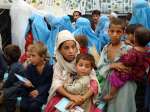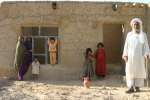World's oldest refugee goes home to Angola
News Stories, 8 February 2005

LUAU, Angola (UNHCR) – At 107, Angolan refugee Silva Kawanda is living proof that you're never too old to go home and start a new life.
Kawanda, believed to be the world's oldest refugee, recently returned to Angola with his wife Paulina Chivela, 86, and 18-year-old grandson after spending more than four years in western Zambia's Nangweshi camp. They were among the last groups to be airlifted back to Luau in Angola's Moxico province before the UNHCR-organised repatriation operation paused in November.
Kawanda's return was as emotional as his escape, which he described as the worst day of his life. In January 2000, he and his wife fled the Angolan town of Jamba, a one-time stronghold of the Union for the Total Independence of Angola (UNITA), after it was bombed and captured during the civil war. They joined more than 15,000 other people forced to flee from the area.
The old couple spent four months in the bush on the way from Jamba to the Zambian border. When they were lucky, they slept on tree leaves spread on the ground. Sometimes, they went without food. Other times, they survived on wild fruits and roots.
"Sometimes we had to follow birds in order to get some of their fruits. When we found a dead animal, we had a special meal that day," Kawanda recalled. "Only God knows our suffering."
Because of his age – 103 then – Kawanda could not walk very long distances. Thankfully, other refugees carried him on improvised stretchers made out of poles and tree fibres. Before reaching Zambia, he and his wife had to cross heavy forest thickets and crocodile-infested rivers and streams, which are numerous in that part of Angola. Yet despite the risks and hardships, Kawanda pushed on as he could not bear to die in the bombings back home.
Kawanda's most vivid memories are of the children he met during the long, arduous trip – separated from their families, alone, running for safety. He said they reminded him of his own children and grandchildren who were killed in the war or died of starvation. He managed to flee with a grandson, but does not know what happened to his 10 children.
Since arriving at Zambia's Nangweshi camp in May 2000, Kawanda has been visited by several senior Zambian government and UNHCR officials. In July 2001, he met UNHCR High Commissioner Ruud Lubbers at the camp.
Home to some 20,000 Angolan refugees, Nangweshi is a relatively new camp of orderly grass huts, which has changed rapidly in terms of infrastructure development over the last few years. Offices, a police station and trading posts have been built, along with new classrooms for children who used to study under trees when the camp just opened.
The camp, however, is isolated. At the height of the rainy season, Nangweshi can be reached only by boat due to seasonal floods. Even in dry weather, travelling by four-wheel-drive vehicles to the camp from the nearest township of Senanga involves a gruelling one-and-a-half-hour journey on a road ravaged by seasonal floods, potholes and a sea of sand.
During his stay at Nangweshi, Kawanda spent most of his time in his hut and occasionally walked around with the help of his wife. But he loved the children at Nangweshi and felt that he had much in common with them despite an age difference of almost a century. He told them tales of African folklore when they visited him in his hut. Stories and encouragement were the only things that could give them hope that one day they would be able to make things better, he said, adding that education for children, in their history and modern vocations, was very important.
Before leaving the camp, Kawanda thanked the Zambian government, the local community and his fellow refugees, and said he would miss the hospitality of his hosts.
"Before, bullets took everyone – men, women and children alike – without choice," he said. "I only wish that now that things are okay, people will go back home to Angola and help rebuild the country." He appealed to all Angolan refugees still in Zambia to take the opportunity offered by UNHCR to return home and contribute to the development of their country.
More than 45,000 Angolan refugees have returned on UNHCR airlifts and land convoys from Zambia since the refugee agency started assisting them to return home in June 2003. Due to the rainy season, the operation is temporarily suspended until May. This year, UNHCR and its partner agencies plan to help repatriate more than 31,000 Angolan refugees from Zambia.
By Kelvin Shimo
UNHCR Zambia
















































